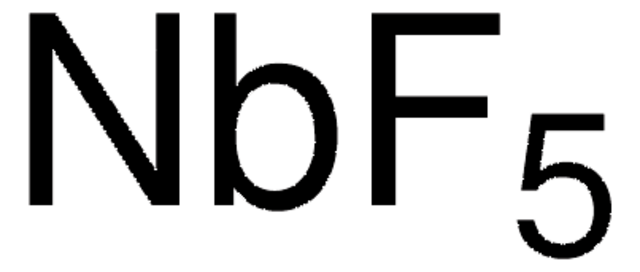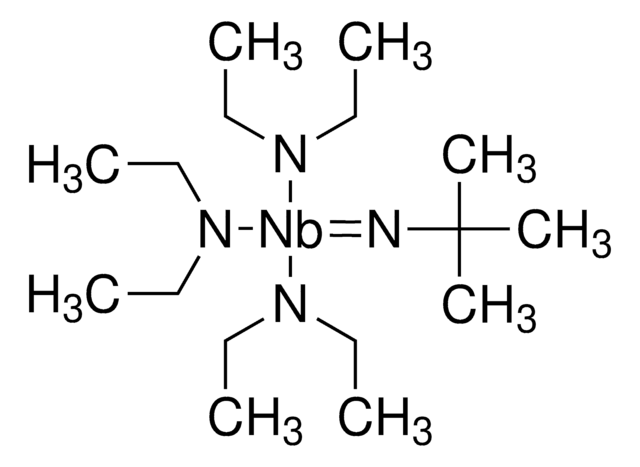215791
Niobium(V) chloride
99%
Synonyme(s) :
Niobium pentachloride
About This Item
Produits recommandés
Pureté
99%
Forme
powder
Technique(s)
FTIR: suitable
Point d'ébullition
254 °C (lit.)
Pf
204.7 °C (lit.)
Densité
2.75 g/mL at 25 °C (lit.)
Chaîne SMILES
Cl[Nb](Cl)(Cl)(Cl)Cl
InChI
1S/5ClH.Nb/h5*1H;/q;;;;;+5/p-5
Clé InChI
YHBDIEWMOMLKOO-UHFFFAOYSA-I
Vous recherchez des produits similaires ? Visite Guide de comparaison des produits
Catégories apparentées
Description générale
Application
- As a precursor to prepare K2NbF7:Mn4+ red phosphors for white light-emitting diode(LED) devices.
- As a Lewis acid to synthesize fluorescein dye derivatives for dye-sensitized solar cells.
- As a dopant to enhance the thermoelectric properties of n-type tin selenide.
- As a precursor to synthesize Nb2O5 microspheres and TiNb2O7 nanoparticles as high-rate capability and long-cycle-life anode materials for lithium-ion batteries .
Mention d'avertissement
Danger
Mentions de danger
Conseils de prudence
Classification des risques
Acute Tox. 4 Oral - Eye Dam. 1 - Skin Corr. 1B - STOT SE 3
Organes cibles
Respiratory system
Risques supp
Code de la classe de stockage
8B - Non-combustible corrosive hazardous materials
Classe de danger pour l'eau (WGK)
WGK 1
Équipement de protection individuelle
Eyeshields, Faceshields, Gloves, type P3 (EN 143) respirator cartridges
Certificats d'analyse (COA)
Recherchez un Certificats d'analyse (COA) en saisissant le numéro de lot du produit. Les numéros de lot figurent sur l'étiquette du produit après les mots "Lot" ou "Batch".
Déjà en possession de ce produit ?
Retrouvez la documentation relative aux produits que vous avez récemment achetés dans la Bibliothèque de documents.
Les clients ont également consulté
Notre équipe de scientifiques dispose d'une expérience dans tous les secteurs de la recherche, notamment en sciences de la vie, science des matériaux, synthèse chimique, chromatographie, analyse et dans de nombreux autres domaines..
Contacter notre Service technique












